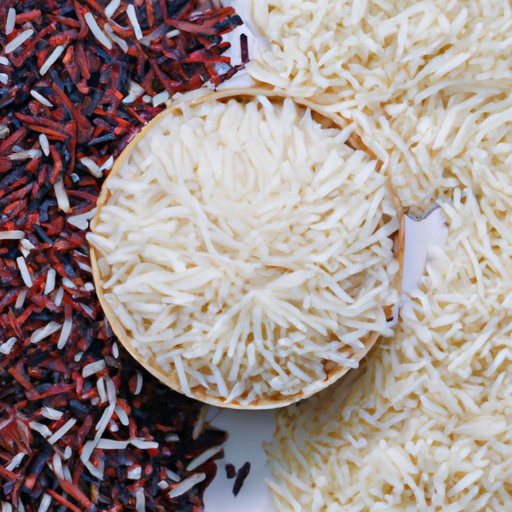Introduction
Rice is a staple food for many cultures around the world and has been consumed for centuries. Brown rice and white rice are two varieties of this grain that are commonly found in grocery stores. While both types of rice contain similar amounts of carbohydrates, they differ significantly in terms of their nutritional content and health benefits. This article explores why brown rice is healthier than white rice.

Exploring the Nutritional Differences Between Brown and White Rice
Understanding the health benefits of eating brown rice can help you make an informed decision when it comes to your diet. Brown rice is considered a whole grain because it contains all parts of the grain kernel—the bran, germ, and endosperm. White rice, on the other hand, has been stripped of its bran and germ layers, resulting in a product with fewer nutrients. Here are some of the key differences between brown and white rice:
Lower Glycemic Index
The glycemic index (GI) is a measure of how quickly foods raise blood sugar levels. Foods with a high GI are digested quickly, causing a rapid spike in blood sugar. Brown rice has a lower GI than white rice, which means it takes longer for your body to digest and absorb the carbohydrates.
Higher Fiber Content
Brown rice is higher in dietary fiber than white rice. Dietary fiber helps regulate digestion, lowers cholesterol levels, and keeps you feeling full longer. It also plays an important role in controlling blood sugar levels and reducing the risk of type 2 diabetes.
More Vitamins and Minerals
Brown rice is richer in essential vitamins and minerals than white rice. It contains more B vitamins, such as thiamin, niacin, and folate, as well as minerals like magnesium, phosphorus, and zinc. These nutrients are important for maintaining energy levels, supporting immune function, and keeping bones strong.

Examining How Processing Affects the Nutritional Content of Rice
To understand why brown rice is healthier than white rice, it’s important to look at how each variety is processed. The main difference between the two is that white rice has had its bran and germ layers removed. The bran and germ are where most of the beneficial nutrients are found, so removing them significantly reduces the amount of vitamins and minerals in the final product.
Removal of Bran and Germ
White rice undergoes a process called milling, which removes the bran and germ layers from the grain. This leaves behind just the endosperm, which is mostly composed of starchy carbohydrates. While this makes the rice easier to cook and digest, it also strips away many of the beneficial nutrients.
Loss of Essential Nutrients
In addition to the loss of vitamins and minerals, the removal of the bran and germ also results in a loss of dietary fiber. Dietary fiber is important for regulating digestion, lowering cholesterol levels, and managing blood sugar levels. Without it, white rice has fewer health benefits than brown rice.
Comparing Brown and White Rice on a Glycemic Index Scale
The glycemic index (GI) measures how quickly foods raise blood sugar levels. Foods with a low GI are digested slowly, while foods with a high GI are digested quickly. Brown rice has a lower GI than white rice, meaning it takes longer for your body to digest and absorb the carbohydrates.
The Role of Fiber in Slowing Digestion
Brown rice is higher in dietary fiber than white rice, which helps slow down digestion and keep blood sugar levels stable. When carbohydrates are digested slowly, the body has more time to absorb the nutrients and use them for energy. This helps prevent spikes in blood sugar levels and can reduce the risk of type 2 diabetes.
Impact of Glycemic Load on Blood Sugar Levels
Glycemic load (GL) is another measure of how quickly foods raise blood sugar levels. It takes into account the amount of carbohydrates in a food and how quickly those carbohydrates are digested. Brown rice has a lower GL than white rice, meaning it has less of an impact on blood sugar levels.
Investigating the Role of Fiber in Brown Rice’s Health Benefits
Dietary fiber is an important nutrient that can have a positive effect on your health. It is found in plant-based foods like fruits, vegetables, nuts, and grains. Brown rice is a good source of dietary fiber, with one cup providing 3.5 grams of fiber. Here are some of the benefits of dietary fiber:
Sources of Dietary Fiber
Fiber is found naturally in many plant-based foods, including fruits, vegetables, legumes, nuts, and grains. Whole grains, like brown rice, are particularly high in fiber. Eating a variety of fiber-rich foods can help ensure you get enough fiber in your diet.
Benefits of Dietary Fiber
Dietary fiber is important for regulating digestion, lowering cholesterol levels, and managing blood sugar levels. It can also help you feel fuller for longer, which can aid in weight loss. Eating plenty of fiber-rich foods, like brown rice, can help you maintain a healthy weight and reduce your risk of chronic diseases.
Conclusion
Brown rice and white rice are two varieties of this grain that are commonly found in grocery stores. Brown rice is higher in fiber, vitamins and minerals, and has a lower glycemic index than white rice. Eating brown rice can help control blood sugar levels and improve digestive health. The bran and germ layers are where most of the beneficial nutrients are found, so removing them significantly reduces the amount of vitamins and minerals in white rice. For these reasons, brown rice is generally considered to be healthier than white rice.
(Note: Is this article not meeting your expectations? Do you have knowledge or insights to share? Unlock new opportunities and expand your reach by joining our authors team. Click Registration to join us and share your expertise with our readers.)
